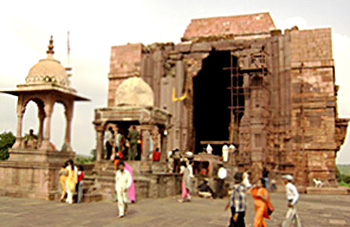 Tourism of Raisen district offers an excellent opportunity to venture into the rich and glorious past of this district of Madhya Pradesh. The most prominent attractions in the district of Raisen are Bhimbetka, Sanchi Stupa and Bhojpur.
Tourism of Raisen district offers an excellent opportunity to venture into the rich and glorious past of this district of Madhya Pradesh. The most prominent attractions in the district of Raisen are Bhimbetka, Sanchi Stupa and Bhojpur.
Sanchi Stupa
Sanchi is a place of immense archaeological and historical importance. It is famous for its stupas and pillars. Some of the stupas have been found possessing relics of the disciples of Lord Buddha. These stupas date as early as the 3rd century and are constructed of bricks made of stone. The Pillar of Asoka is one of the many pillars. These are scattered in the area some of these are in broken and some in shape. It is an excellent example of the Greco-Buddhist style and is known for the aesthetic proportions and the exquisite structural balance. Bhojpur is a place of great tourist interest in this district, which is named after Raja Bhoj. The place is renowned for the remains of its magnificent Lord Shiva Temple and Cyclopean dam.
 Regardless of the damage and restoration work done, Sanchi holds the reputation of the most evocative and attractive Buddhist sites in India even today. Sanchi is mainly a place of Stupas and pillars but the gorgeous gateways add grace to the place. These gateways are the finest specimens of early classical art, which formed the seedbed of entire vocabulary of later Indian art. The images carved on the pillars and the stupas tell moving story of the incidents from the life of Buddha. Though most of the stupas are in ruins now three remain intact and are of great archaeological value. The designs and the carvings on the walls and gates of these stupas spell a heavenly grace. Other attractions of Sanchi are the Four Gateways, the Ashoka Pillar, the Buddhist Vihara, the Great Bowl, the Gupta Temple, the Museum maintained by the Archaeological Survey of India, etc.
Regardless of the damage and restoration work done, Sanchi holds the reputation of the most evocative and attractive Buddhist sites in India even today. Sanchi is mainly a place of Stupas and pillars but the gorgeous gateways add grace to the place. These gateways are the finest specimens of early classical art, which formed the seedbed of entire vocabulary of later Indian art. The images carved on the pillars and the stupas tell moving story of the incidents from the life of Buddha. Though most of the stupas are in ruins now three remain intact and are of great archaeological value. The designs and the carvings on the walls and gates of these stupas spell a heavenly grace. Other attractions of Sanchi are the Four Gateways, the Ashoka Pillar, the Buddhist Vihara, the Great Bowl, the Gupta Temple, the Museum maintained by the Archaeological Survey of India, etc.
Bhimbetka
Bhimbetka in another major attraction in Raisen district possessing more than six hundred rock shelters belonging to the Neolithic age. There are over five hundred paintings on canvas, which depict the life of the prehistoric cave dwellers. Bhimbetka is surrounded by the northern fringe of the Vindhya Mountain Range. It is forty-six kilometers away from Bhopal. It is a rocky terrain of dense forest and craggy cliffs, where over six hundred rock shelters belonging to the Neolithic age were discovered recently. Here, in vivid, panoramic detail, paintings in over five hundred caves depict the life of the prehistoric cave dwellers; making is an archaeological treasure, an invaluable chronicle in the history of man. Prepared mainly in red and white with the occasional use of yellow and green, with themes taken from everyday events of Aeons ago, the scenes usually depict hunting, music, dancing, elephant and horse riders, animals fighting, honey collection, decoration of bodies, disguises, masking and household scenes. Popular religious and ritual symbols also occur frequently in these cave paintings.
The colours used by the cave dwellers were prepared combining manganese, haematite, soft red stone and wooden coal. Sometimes animal fat and extracts of leaves were also used in the mixture. The colours have remained intact for many centuries due to the chemical reaction resulting from the oxide present on the surface of the rocks. The superimposition of paintings shows that different people used the same canvas at different times.
Bhojpur
Bhojpur is one of the most prominent centres of tourist interest in the district of Raisen in Madhya Pradesh state. Founded by the legendary king of Dhar of Parmaras Raja Bhoj, and named after him, Bhojpur is twenty-eight kilometres from Bhopal. It is known for the remains of the Cyclopean dam and the magnificent Shiva Temple, Bhojpur. The temple, which is famously called the Somnath of the East, is known as the Bhojeshwar Temple. Four pillars support the richly carved dome. In the west of Bhojpur was a vast lake, but nothing remains except the ruins of the magnificent old dams by which its waters were contained. The lake was destroyed by Hoshang Shah of Malwa (1405-1434), who cut through the lesser dam, and thus, either intentionally or in a fit of destructive passion, added an enormous area of the highest fertility to his possessions. According to a Gond legend, it took three months for the army to cut through the dam, and the lake took three years to empty, while its bed was not habitable for thirty years afterwards. The climate of Malwa is said to have altered by the removal of this vast sheet of water.



















